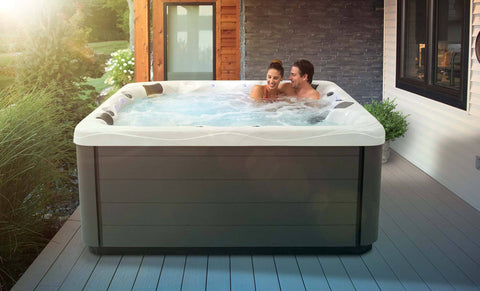
Stop the Foam in Your Hot Tub
Just imagine you've had a long day and it's a perfect evening for a soak in the hot tub. However, when you remove the hot tub cover, you discover that the water is cloudy and foam in accumulating on the surface of the water. This moment happens to all hot tub owners. A couple of questions may come to mind in this situation like Why is there foam in my hot tub? or Is foam in my hot tub okay?

Foam on the surface of you hot tub's water is a sign of imbalance. It is a sign that your hot tub water contains high levels of surfactants. These surfactants are left behind by you and your tub's other bathers. Substances that add surfactants to your hot tub include lotions, soap residue, laundry detergent, and make up.
When air is forced into your hot tub water these surfactants will aid in the production of foam. The combination of air, water, and surfactants is the perfect recipe for foam. There are water conditions that can enhance the production of foam including pH, alkalinity, and calcium balance.
Is Foam In Your Hot Tub Bad?

Foam in your hot tub is an indication of a problem. A foamy hot tub will not resolve itself and will likely get worse as you continue use your hot tub. Depending on the nature of the problem, the water may or may not be harmful to your skin and eyes. If the water in the tub is still clear, it's probably not going to harm your skin but it does need to be addressed soon. Often, clear water with light foam on the surface can be resolved by increasing the level of sanitizer (chlorine or bromine). Keeping your hot tub water balanced, filtered, and maintaining proper sanitizer levels should prevent foaming.
If you encounter foam in your hot tub even though all other conditions are balanced and normal you can use an anti-foaming agent in your hot tub. No foam products for your hot tub work by releasing the surface tension of the water that enables foam to build up. A good anti-foaming product will not otherwise change the chemistry of your hot tub. These products are easy to use and work very quickly.
If you live in an area that is known to have soft water, having a very low mineral content (calcium and magnesium), your hot tub will be more likely to produce foam when surfactants are present. If this is the case, you may want to add a hot tub calcium increaser to your hot tub. This addition will reduce the likelihood of foaming. Having a calcium hardness level between 150-250 ppm helps to prevent corrosion and scale buildup in your spa. This range ensures that your spa remains in optimal condition, allowing you to enjoy it for years to come. You should add a calcium increaser whenever you hot tub tests for 85 ppm calcium or less.

Sitting in a hot tub might be one of the best things ever. Never let your enjoyment of your hot tub be interrupted by foam. It's a simple problem that has a simple solution. Just keep your water balanced, filtered, and if you have soft water, make sure to pay attention to your calcium levels. If foaming does still occur, simply add your favorite anti foaming agent.
It is important to understand your hot tub water chemistry. Balanced water will help you enjoy clean, clear, foam-free bathing for years to come.
You May Also Enjoy
Muriatic Acid in Swimming Pools and Hot Tubs
Hot Tub Maintenance Simplified
Calcium Hardness in Swimming Pools
